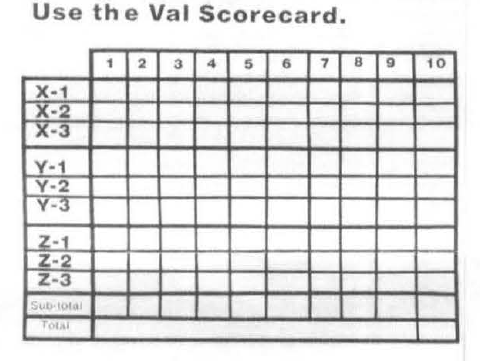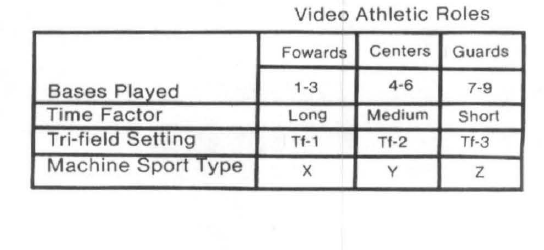A few months back, I posted about the American
Video Athletic Association. Since, I have exchanged e-mails with its founder so
I thought I’d do a follow-up post with more details.
In January 1982, Time magazine ran a cover story on the video game phenomenon that
was then sweeping the country. The article featured a sidebar on a teenager Steve
Juraszek, who had played a single game of Defender
for over 16 hours. Walter Day considers the issue’s cover date (January 18,
1982) to be the birthdate of the golden age of video arcades. It was also a key
date in the history of eSports, if for no other reason than that it indirectly
lead Day to establish his Twin Galaxies Video Scoreboard, one of the earliest
serious attempts to make video gaming a sport.
While Day’s efforts are well known, however,
and many consider him the father of eSports, he was not the only person to
think of the concept. At least two others were making similar efforts in 1982.
One of them was an entrepreneur in Madison, Wisconsin named Dennis de Nure.
According to his autobiography, Dennis was born John Michael DeNure
in 1956 in Platteville, WI (“home of the world’s largest M symbol”) and changed
his name to Dennis Amadeus de Nure after seeing the film “Amadeus[1].” In 1982, around the time
Walter Day was starting his famous scoreboard, DeNure was playing Pac-Man at bars in the Madison area and
thought, “how neat it would be to turn video game playing into a sport that I
trademarked.” While Walter Day wanted to bring glory to the players, however, DeNure
had another motive. He wanted to get rich, and he thought that the way to do so
was to secure the intellectual property rights to the concept of video gaming
as a sport.
Toward that end, on April 5, 1982, DeNure incorporated
a company called Video Athlete Corporation, which was located at 120 W.
Mifflin Street in Madison. He persuaded his landlord, Otto Zerwick, to invest
$15,000 in the company, which at that point consisted of little more than a
name and a trademark on the term “Video Athlete” (though the trademark was not filed until July
6[2]). With cash in hand, DeNure
hit upon an odd publicity stunt to promote his new idea. Over drinks, he got to
know the elephant keeper at the Dane County Zoo and persuaded the keeper to let
him sneak into the elephant enclosure with a Defender cabinet and take pictures of the zoo’s star pachyderm,
Winkie, “playing” the game. It was dangerous business. In 1966, Winkie’s predecessor,
also named Winkie, had stomped a three-year old to death and the second Winkie would
later send a handler to the hospital and, after being moved to an elephant
sanctuary in 2000, kill another handler. Nonetheless, DeNure entered the temperamental
elephant’s cage and, by placing a peanut on top of the game, got her to pick it
up with her trunk, making it appear that she was moving the joystick. Another
photo showed three gamers playing games in front of the Madison skyline with
the logo “We Are Athletes of a Different Kind.” While the photos did not really
lead to anything, they did put DeNure in touch with a local arcade owner, who
had supplied the games for the photo shoots.
Now that he had a source of games, DeNure
began to think of ways to promote his idea. His initial plan was to have a semi-trailer
full of video games that would travel the country. First, however, he decided
to stage a tournament in Madison, initially to be called the Video Athlete
Festival, sponsored by the “American Video Athletic Association” (aka AVAA or
ah-vah), another group DeNure had created. DeNure had an audio technician create
a 60-second radio commercial for the event and booked a spot at the Dane County
Forum. In addition to individual and team tournaments, the festival would have door
prizes, representatives from various video game factories, a “video guru”
comedy act, and over 100 video games. DeNure even paid Steve Juraszek to come
to Madison to attempt to break his famous record and persuaded an AP reporter
and photographer to cover the attempt. It was an impressive plan, especially
for 1982. But it never came off.
On May 21, the day before the festival, DeNure
ran an ad in the Madison Wisconsin State
Journal. The tournament, sponsored by “Video Athletes Across America” (yet another
DeNure creation) would feature six different games: Centipede, Defender,
Tempest, Donkey Kong, Pac-Man, and Omega Race. Juraszek would be on hand, where
he would be challenged by Robert Crocker, an 11-year-old local video game “expert.”
At the last minute, however, the arcade owner pulled out and rather than trying
to salvage the situation, the now-bitter DeNure cancelled the event. In the end,
it may not have mattered, since by his own admission, DeNure did not really
know what he was doing at the time.
He did not give up on video athletes, however
and instead began thinking of new ways to promote the concept. He created an ad
for the American Video Athletic Association that ran in the July and August
issues of Electronic Games featuring
the likeness of Steve Juraszek and offering a one-year membership in the AVAA
for $12.95. Gamers could also submit their high scores without joining the
association. If they did join, they got a t-shirt, membership card, quarterly newsletter,
and “handy pocket guide to Video Athletics” that included gameplay hints,
comparison charts, and a rating system with five ranks: Scrambler, Defender,
Commander, Invader, and Avenger.
Meanwhile, DeNure started writing letters seeking
supporters his idea to just about anyone he could think of, getting nothing in
return but rejections. George Lucas’s secretary told him the George’s daughter
loved the shirt, but passed. Arthur C. Clarke suggested that DeNure read his
essay “The Playing Fields of Space.” Isaac Asimov was too busy and Ted Turner
said “no” multiple times. His letters to coin-op manufacturers, distributors,
and operators did not fare much better, though he did get a meeting in a
McDonald’s with Atari’s Joe Robbins, who suggested that he do a survey.
DeNure also was toying with a number of other names,
phrases, and concepts that he hoped to trademark, like “Video Athlete League
(VAL),” “Machine Sports,” and “make sport not war.” His most ambitious idea involved
something he called the Video Athletic Machine Sport, or VAMS, unit. The VAMS
unit, which would be built into newly created video games, would include a “video-tac”
(video tachometer) dialog board that would provide a “Universal Scoring System”
to convert scores to a 100-point scale, a “Universal Time Factor System” that
allowed the player to select short, medium, or long games, and a “Universal
Tri-Field Setting System.” A group called the “AVAA-Control Committee” would determine
how to convert the scores for different games and difficulty levels. VAMS was
part of a more elaborate plan to turn video gaming into a competition along the
lines of baseball or basketball. Competitions, which be played in arenas called
an “Electronic Ball Parks,” would consist of a ten-inning “game” between two
teams of nine players. Each team would have three forwards, three guards, two
centers, and a “signal captain.” Games were divided into one of three types and
could be played for one of three durations. During each inning, team members
would play specific games for specific lengths of time at specific difficulty
levels based on the inning and their position. Based on their score, players would
be awarded a single, double, triple, home run, or grand slam, earning one to
five points, which would then be converted into “conversion points” (the
details here are a bit hazy).To add an element of chance, a “VAL Baseline
Spinner” was created, though even DeNure no longer what it was supposed to be
used for. It was an elaborate system – probably too elaborate – but DeNure
hoped that once industry movers and shakers were onboard, they would simplify
and improve it.
DeNure’s master plan involved more than just
tournaments, however. A professional team called the Star Scorers would be formed.
Gyms called “valcades” would be established where players could play against
other video athletes for $5. A language called “AVAA-Talk” would be created.
Playoffs, like the Crown of AVAA, would be held. Tournaments would be promoted on
a TV show called Planet Play. DeNure even wrote a 108-page screenplay for a
movie called “Star Scorers of the AVAA” intended to educated consumers about
video athletics[3]
as well as a book called “The Age of the Video Athlete.” Other ideas included a
national organization for operators (which would promote tournaments), a
quarterly newsletter listing everyone who achieved a high score on one of 15
selected games per month in member arcades, a syndicated comic strip, video
game triathlons, and an arcade t-shirt with a special pocket for tokens.
Unfortunately, ideas are all DeNure had and he
was never able to interest anyone in turning them into reality. Very few people
joined the AVAA (the pocket guide and newsletters eventually became a booklet
called “The New Peace Sign”). DeNure does seem to have published The Age of the Video Athlete, which was
listed in the bibliography of a book called Reading
Programs For Young Adults. It was also mentioned in the June 1, 1983 issue
of Play Meter, which described it as
a 98-page manual on promoting video games as a sport, with details on running
sanctioned “Video Game Festivals”, including sample radio ads, and other info. By
1987, DeNure seems to have dropped the video athletics idea and moved on to
other things.
In 1985, he was running a shoeshine stand in Madison.
In October 1986, the Madison Capital
Times reported that he was pushing to have the state motto changed to “Eat
Cheese or Die.” In April 1987 the Wisconsin
State Journal reported that he was running a shop called DeNure’s T-Shirt
Factory and 60s Museum at 555 State Street, selling tie-dyed T-shirts and 60s
memorabilia. Two months later, the Journal
reported that DeNure’s “travelling cow cart” had been robbed of its entire
inventory of cow-themed t-shirts, bearing slogans like “Cows are udderly cool.”
The cart was mounted on a snow mobile trailer that DeNure pulled around
the state with his van to various farm events.
Late in 1987 (if not earlier), DeNure launched
his political career with a run for Dane County Executive. In early 1988, he pleaded
no contest and was fined for hurling apples at a Richard Haas mural being
painted at Olin Terrace. Later that year, he entered the race for mayor.
Starting around 1993, he ran a store in Madison called Game Haven that sold
Magic the Gathering and Pokémon cards, as well as board games and Beanie
Babies. In 2002, he served a two-year sentence in Iowa for drunk driving. As of this writing, he is apparently still designing t-shirts and pushing for one
of his other big ideas – the Museum Mile.
[1] DeNure was using the name “Dennis,”
however, long before the film was released.
[2] The trademark application gives a “first
use in commerce” and “first use anywhere” of April 15, 1982. DeNure remembers
that he had the trademark before he began planning his tournament. He also
remembers that he had some ads in national magazines, but that appears to have
come later.
[3] Some of these ideas may have come after
1986.

























The most comprehensive information on DeNure I have ever seen. Thank you.
ReplyDeleteno doubt haha. I remember when he was asking for ideas from some of us odyssey players... just knew it was never gonna happen... ahead of his time, though
ReplyDelete